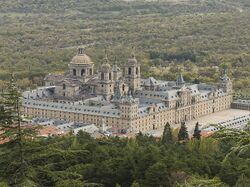The Hermitage (Cálfeld)
This article is a work-in-progress because it is incomplete and pending further input from an author. Note: The contents of this article are not considered canonical and may be inaccurate. Please comment on this article's talk page to share your input, comments and questions. |
| The Hermitage | |
|---|---|
 Exterior of the Hermitage | |
| General information | |
| Architectural style | Cistercian architecture (original) Herrerian style (present structure) |
| Location | Cálfeld |
| Country | Urcea |
| Named for | Order of monks |
| Construction started | 1180 AD |
| Owner | Government of Urcea |
| Known for | Residence of the Grand Duke of Harren |
The Hermitage is a royal residence of the Apostolic King of Urcea on the outskirts of Cálfeld, the cathedral city of Harren. It is the official residence of the King in his role as Grand Duke of Harren. It traditionally serves as the Apostolic King's winter residence. By convention, the Apostolic King also resides at the Hermitage when visiting any of the southeastern provinces or Gassavelia, only staying within a different jurisdiction under emergency circumstances.
History
The oldest parts of the palace now known as the Hermitage was erected by Cistercian monks around 1180 AD and was known as the Abbey of St. Mary. Several miles to the south of the major city of Cálfeld on the fringe of the Southern Wilderness, the location was considered ideal for contemplative isolation while still being viable for agriculture, for which the Cistericans were well known. Beginning as a small chapel with adjoining residence, the structure continued to grow reaching its peak monastic form in about 1310. The finished monastery was designed around the perceived layout of Solomon's Temple in the unique Cisterican architecture. During the Saint's War, the structure's location became a strategic staging area for forces loyal to House de Weluta due to its relative location northwest of Ardricampus, the home of the de Weluta's enemies during the conflict. Accordingly, the Abbey became a frequent resting place of de Weluta princes, and became the primary resting place of the de Welutas once they assumed the throne of Urcea in 1401. Despite its austerity, the Abbey remained a favorite of de Weluta kings when visiting their subjects in Harren. Its location on the periphery of the Wilderness made it an attractive place for the de Welutas to winter, and their visits to the Abbey became increasingly common. In 1498, King Adrian III agreed to an arrangement with the Cisterican monks wherein the Crown would acquire the entire monastery in exchange for thirty thousand acres in the Archduchy of Urceopolis, a considerable amount of land, on the condition that a small group of Cistericans would be able to remain to continue their lifestyle. The King agreed to this condition, and the large chapel at the heart of the Abbey would remain a fixture upon its transformation into a Palace.
The Palace had no official name upon its conveyance to the Apostolic King of Urcea, and it was commonly referred to as "the southern palace" until wintering there became an established tradition under Adrian III in 1532. The term Hermitage both referred to the original status of the building as a monastery as well as a tongue-in-cheek reference to the relative isolation of the Kings relative to Urceopolis. The structure was mostly unused during the reign of the House of Julio-Angloise, and resumed its original wartime convenience to the de Welutas when Leo de Weluta assumed relative regular residence here during his campaigns against the Julio-Angloise. Leo remained fond of the structure after becoming Apostolic King of Urcea, and began a major renovation and expansion of the structure in 1573 in the Herrerian style. Much of the underlying structure of the original Abbey remained in tact, but the exterior of the building was completely redesigned and the chapel was significantly expanded vertically. The interiors, still bearing many of the austere cells appropriate to a monastery, were completely renovated to be befitting of a palace. Three original cells remained in order to house the three Cisterican monks who were to reside in the building, and the cells remain in their original condition as of the 21st century. In 1580, in part as thanks for the role of House de Weluta in restoring the Pope to the Papal State during the Great Confessional War, the chapel of the Hermitage was established as the "Basilica of Saint Stephen". House de Weluta has attended the Hermitage every winter ever since, with the exception of during the Red Interregnum, and the King's departure from Urceopolis each winter has become a highly ritualized event. During the Second Great War, the Apostolic King spent considerable time in the Hermitage, and during that time it was completely renovated with modern conveniences.